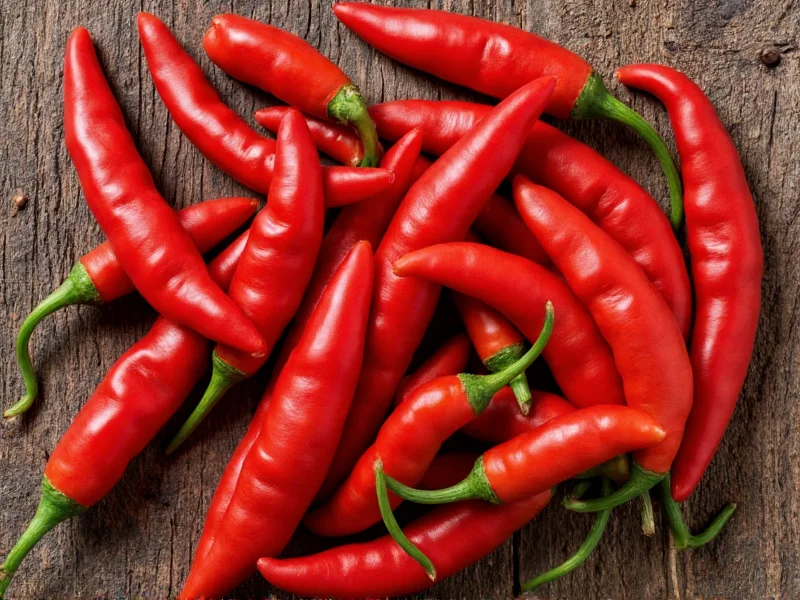When exploring mild chilies, understanding the Scoville scale is essential for selecting peppers that match your heat tolerance. Unlike their fiery counterparts, mild chili varieties deliver complex flavors while remaining accessible to most palates. These peppers serve as perfect entry points for spice newcomers and valuable ingredients for chefs seeking nuanced flavor profiles without intense heat.
Understanding Chili Heat Measurement
The Scoville scale, developed by pharmacist Wilbur Scoville in 1912, measures capsaicin concentration—the compound responsible for chili heat. Modern testing uses high-performance liquid chromatography for precise measurements, but the Scoville Heat Unit (SHU) remains the standard reference. Mild chilies register below 5,000 SHU, creating a comfortable range for everyday cooking.
Top Mild Chili Varieties Compared
| Chili Variety | Scoville Range | Flavor Profile | Best Culinary Uses |
|---|---|---|---|
| Bell Peppers | 0 SHU | Sweet, grassy, vegetal | Raw salads, stuffed peppers, stir-fries |
| Poblano | 1,000-2,000 SHU | Earthy, slightly sweet, raisin-like | Chiles Rellenos, mole sauces, roasted dishes |
| Anaheim | 500-2,500 SHU | Grassy, slightly tangy, mild bitterness | Southwestern dishes, green chili stew, roasted applications |
| Cubanelle | 0-1,000 SHU | Sweet, mild, slightly floral | Italian and Puerto Rican cuisine, frying, stuffing |
| Guernsey | 0-2,000 SHU | Fruity, sweet, minimal heat | Fresh salsas, pickling, raw applications |
Culinary Applications of Mild Chilies
Chefs increasingly recognize mild chilies as versatile flavor enhancers rather than just heat sources. When cooking with mild chili pepper varieties for beginners, consider these professional techniques:
- Roasting and peeling poblano peppers develops their natural sweetness while maintaining mild heat levels
- Substituting mild chilies instead of hot in traditional recipes makes dishes accessible to wider audiences without sacrificing authenticity
- Preserving mild chili peppers through freezing or pickling extends their seasonal availability
- Combining different mild varieties creates complex flavor layers in sauces and stews
For those with sensitive stomachs, mild chili peppers offer capsaicin benefits without gastrointestinal discomfort. The compound actually stimulates endorphin production while providing vitamin C and antioxidants. Many professional kitchens now feature dedicated mild chili menus to accommodate diverse heat preferences.
Growing Mild Chilies at Home
Growing mild chili peppers at home proves surprisingly simple for gardeners of all experience levels. These varieties typically require:
- 6-8 hours of direct sunlight daily
- Well-draining soil with pH between 6.0-7.0
- Consistent moisture without waterlogging
- Temperatures above 70°F (21°C) for optimal growth
Beginner gardeners should consider starting with Cubanelle or Guernsey peppers, which demonstrate higher disease resistance and more forgiving growth patterns. When harvesting, look for fully colored peppers that feel firm to the touch—this indicates peak flavor development while maintaining mild heat characteristics.
Substituting Mild Chilies in Recipes
Understanding mild vs hot chili peppers comparison helps adapt recipes to personal preferences. When substituting:
- Replace one jalapeño with two Anaheim peppers for similar volume with reduced heat
- Use roasted poblano instead of serrano in salsas for earthy depth without intense spice
- Combine bell peppers with a small amount of mild chili for color and subtle flavor enhancement
Professional chefs often create layered heat profiles by combining mild and medium-heat chilies, allowing diners to adjust spice levels to their preference. This approach works particularly well for family meals or restaurant dishes serving diverse palates.
Health Benefits of Mild Chili Varieties
Research confirms that even mild chili peppers deliver significant health advantages. The capsaicin present in mild varieties:
- Boosts metabolism by up to 5% for several hours after consumption
- Provides 169% of daily vitamin C in a single poblano pepper
- Contains antioxidants that support eye health and immune function
- Promotes circulation without the cardiovascular strain of hotter varieties
Unlike extremely hot chilies that may cause digestive irritation, mild varieties offer these benefits with minimal risk of discomfort, making them suitable for regular consumption. Nutritionists increasingly recommend incorporating mild chili peppers into daily diets for their flavor and health properties.
Frequently Asked Questions
What's the mildest chili pepper variety available?
Bell peppers are technically the mildest chili variety with 0 Scoville Heat Units. Among hot pepper varieties, Cubanelle peppers (0-1,000 SHU) and Guernsey peppers (0-2,000 SHU) offer the gentlest heat while still providing authentic chili flavor.
Can I substitute mild chilies for hot ones in recipes?
Yes, you can substitute mild chilies for hot ones, but you'll need to adjust quantities. For example, replace one jalapeño with two Anaheim peppers to maintain similar volume while significantly reducing heat. Keep in mind that mild varieties may lack some of the complex flavor compounds found in hotter chilies, so consider adding complementary ingredients like smoked paprika to maintain depth.
Why do some mild chilies occasionally taste hotter than expected?
Mild chili heat can vary due to growing conditions, with stress factors like inconsistent watering or extreme temperatures increasing capsaicin production. The seeds and white membranes contain the highest concentration of capsaicin, so removing these parts reduces heat. Additionally, individual sensitivity to capsaicin varies significantly between people.
How can I reduce the heat of a dish that's become too spicy?
To reduce heat in an over-spiced dish, add dairy products like yogurt or sour cream, which contain casein that binds to capsaicin. Acidic ingredients like lime juice or vinegar can also help balance heat perception. For best results, incorporate mild chili peppers for sensitive stomachs by adding them gradually while tasting, and always remove seeds and membranes before cooking.
Do mild chilies provide the same health benefits as hotter varieties?
Mild chilies deliver many of the same health benefits as hotter varieties, including high vitamin C content and antioxidant properties, though in slightly lower concentrations of capsaicin. The health benefits of mild chili peppers make them suitable for regular consumption without the potential digestive irritation associated with hotter peppers, providing a sustainable way to incorporate these advantages into your diet.











 浙公网安备
33010002000092号
浙公网安备
33010002000092号 浙B2-20120091-4
浙B2-20120091-4